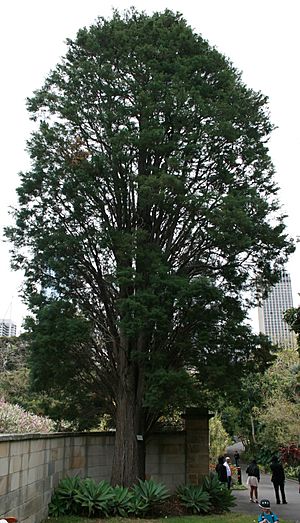Mexican cedar facts for kids
Quick facts for kids Mexican cedar |
|
|---|---|
 |
|
| A mature Cupressus lusitanica | |
| Conservation status | |
| Scientific classification | |
| Genus: |
Cupressus
|
| Species: |
lusitanica
|
| Synonyms | |
|
Synonymy
Callitropsis lusitanica (Mill.) D.P.Little
Cupressus coulteri J.Forbes Cupressus excelsa J.Scott ex Carrière Cupressus glauca] Lam. Cupressus karwinskiana Regel Cupressus lindleyi Klotzsch ex Endl. Cupressus mexicana K.Koch Cupressus pendula L'Hér. 1785 not Thunb. 1784 Cupressus sinensis J.Lee ex Gord. Cupressus thurifera Lindl. Cupressus uhdeana Gordon ex Carrière Hesperocyparis lindleyi (Klotzsch ex Endl.) Silba Hesperocyparis lusitanica (Mill.) Bartel Juniperus uhdeana Gordon Neocupressus lusitanica (Mill.) de Laub. Callitropsis benthamii (Endl.) D.P.Little Cupressus benthamii Endl. Cupressus ehrenbergii Kunze Cupressus knightiana Perry ex Gordon Hesperocyparis benthamii (Endl.) Bartel plus many more names at the level of subspecies, variety, or form |
|
The Mexican cedar, also known as cedar-of-Goa, is a type of cypress tree. Its scientific name is Cupressus lusitanica. This tree originally comes from Mexico and Central America. You can find it in countries like Guatemala, El Salvador, and Honduras. It has also been brought to Belize, Costa Rica, and Nicaragua. These trees usually grow at high altitudes, between 1,200 and 3,000 meters (about 3,900 to 9,800 feet) above sea level.
The name lusitanica means "from Portugal". This is because the tree was first grown there a very long time ago. Plants from Mexico were brought to a monastery in Portugal around 1634. When the tree was officially described by Miller in 1768, those trees were already over 130 years old! In Mexico, people also call this tree cedro blanco (white cedar) or teotlate.
Contents
Discovering the Mexican Cedar Tree
The Mexican cedar, Cupressus lusitanica, is an evergreen conifer tree. This means it keeps its leaves all year round. It can grow very tall, up to 40 meters (about 130 feet). Its top part, called the crown, looks like a cone or an egg shape.
Leaves and Cones
The leaves of the Mexican cedar are small and look like scales. They are about 2 to 5 millimeters long. The leaves grow in thick clusters and are usually dark green, sometimes with a yellowish-green color. The branches where the leaves grow are rounded, not flat.
The tree produces cones that hold its seeds. These cones are round or slightly oval. They are about 10 to 20 millimeters long and have four to ten scales. When they first appear, they are green. After about 25 months, they turn brown or grey-brown.
How Cones Release Seeds
Some cones open when they are ready to release their seeds. Other cones stay closed for several years. These closed cones only open after a wildfire kills the parent tree. This allows the seeds to spread and grow on the newly cleared ground. Male cones are smaller, about 3 to 4 millimeters long. They release pollen in late winter or early spring. In its natural home, this tree gets most of its rain during the summer.
Different Types of Mexican Cedar
There are two main types, or varieties, of Cupressus lusitanica. Some scientists even consider them to be different species.
- Mexican Cypress (Cupressus lusitanica var. lusitanica): This type has leaves that spread out in all directions, making the branches look full. It grows in areas that get less rain. This variety is considered a Least concern species, meaning it's not currently at risk.
- Bentham's Cypress (Cupressus lusitanica var. benthamii): This type has flatter leaves that grow mostly in one direction. It prefers places with more rainfall. This variety is listed as Near Threatened, meaning it might be at risk in the future.
Growing and Using Mexican Cedar Trees
The Mexican cedar grows quickly and can handle dry weather. However, it doesn't do well in very cold, frosty conditions. People have brought this tree from Mexico to many parts of the world. It is widely grown for two main reasons: as an ornamental tree (for its beauty) and for its timber (wood). It thrives in warm, mild, and subtropical climates. Trees from northern Mexico are especially good at handling drought, but they haven't been chosen much for planting.
Where Mexican Cedars Are Grown
Mexican cedars have been planted in many places, especially in southern Asia. Sometimes, people confuse them with native Asian cypress trees. For example, trees sold as Cupressus torulosa by nurseries are often actually Mexican cedars.
These trees are planted for commercial use in many countries:
- In high mountain areas of Colombia (up to 3,300 meters), Bolivia, Ethiopia, and South Africa.
- Near sea level throughout New Zealand.
In Colombia, farmers plant these trees to create windbreak hedges. These hedges protect crops and homes from strong winds. They also help stop soil from washing away on slopes. Since the 1990s, mountain farmers in Tanzania have planted them to protect soil and for their wood.
Mexican cedars are also popular as ornamental trees in places with mild climates near the sea. They grow very well in Portugal, Buenos Aires Province in Argentina, Austin, Texas in the USA, and the British Isles. In these places, they can reach heights of 30 meters (about 90 feet).
In the San Luis province of Argentina, people are planting Mexican cedars to create new forests. This area originally had very few trees, and the climate is similar to where the Mexican cedar naturally grows.
See also
 In Spanish: Cedro americano para niños
In Spanish: Cedro americano para niños
- Cedar wood




